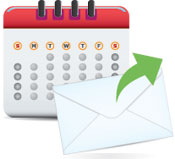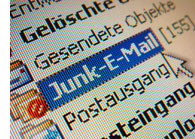A long term
email campaign will have a clear effect on every aspect of any business. The full range of products and services your manufacturing and distribution business may provide is likely unknown to your prospects, and there is no other promotional opportunity that comes close to the impact and return on investment of properly implemented and well-designed email marketing. A successful campaign must take note of the following factors:
Implementation
Email marketing is different from placing a listing in the Yellow Pages or Thomas Register, or running an ad in trade magazines, newspapers, radio or television: the legal requirements for online advertising are much more strict, particularly concerning how a customer is approached and marketed to.

Compliance
Your manufacturing or distribution business should retain documented consent from clients prior to placing them on your subscription list.
Federal CAN-SPAM Law Violations Are a Crime
The US
CAN-SPAM Act regulates email marketing and how businesses must interact with clients online. CAN-SPAM is "opt-out" legislation, requiring all commercial business units to immediately act upon a subscriber's request to be removed from an email list serve. Failure to comply with this legislation opens up a business owner or manager to heavy fines and potential sentencing.
Make It Easy to Unsubscribe
Your manufacturing or distribution business must immediately comply with a customer's request to be removed from your subscriber list. Additionally, every email you send must contain an easy to see, easy to enact link allowing the user to opt out of your online services (often known as an unsubscribe link).

Manage Bouncing Emails
When your manufacturing or distribution business sends out an email - regardless of whether it is a personal message, a business reply or an
email newsletter - one of three different things will occur.
The send is delivered as planned.
The send is delayed due to a problem with your customer's email account or some network problem. This is called a soft bounce.
The send will be delivered because the email address cannot be found or has been blocked. This is called a hard bounce.

If your email bounces, you will receive a message from an Internet function called Mailer Daemon, informing you of the problem and explaining the reasons for the bounce. Soft bounces are an issue with the user's system, and it is suggested that you attempt to contact them via other means to alert them of the situation. In the case of a hard bounce, it is necessary to remove that user's address from your list: if you continue to send missives to a blocked address, eventually your address will be placed on a spam blacklist, and you will no longer be able to send any sort of email – business or personal – from your address.
Privacy Policy
It is important that you have a privacy policy drafted for your specific business unit. Though it may be tempting to visit a competitor's website and "borrow" their policy language, your privacy policy must be tailored to your specific online business activities in order to protect you from legal liability. Always contact an industry-specific business attorney and craft your own privacy policy.
Segment Your List
Segmenting your subscriber list will help expand your customer base and better serve your current clients. A customer operating a single corner store location has different requirements than a national chain purchasing agent: segment your list to create separate email campaign content for different demographic and behavior patterns. This ensures each category receives offers and information relevant to their interactions with your manufacturing or distribution company.
Test Your Ongoing Content

The A/B split is a popular and effective test that allows you to determine how your customer base will respond to varying specific elements within an email. By changing just one parameter, such as the
preheader or the subject line, and analyzing the open and click-through rates, you will be able to determine how your subscribers react to isolated changes. Their reactions and responses will allow you to craft a more focused email strategy for the future.
Capture Your Customer's Personal Data
Like many consumers, manufacturing or distribution clients may be hesitant to turn over their personal information to your campaign efforts. However, your business needs this data for critical segmentation efforts. Many manufacturing and distribution outlets have discovered the most effective way to retain this data is through incentivized surveys, which draw information from customers by providing discounts, personalized prizes or other items.
Analyze Your Customer's Behavior

Open and click-through rates are primary indicators of subscribers' behavior towards your manufacturing or distribution business. From these metrics, you will discover three types of consumers.
Consumers who do not open your emails ever and should be removed from your list
Consumers who may open your emails but never click through to your call to action and should remain on the list, lest they be engaging your business through other modes of communication
Consumers who open your emails and respond to your call to action and should remain on your list; these are your most valuable clients
Best Email Practices
Manufacturing and distribution businesses should always strive to follow best email practices, including:
Preheaders and subject lines composed with great care
Updated email templates that can handle video and varying display characteristics to work on different browsers and Web-enabled mobile devices
Multiple landing pages featuring targeted content to dovetail with your segmentation efforts and A/B split testing